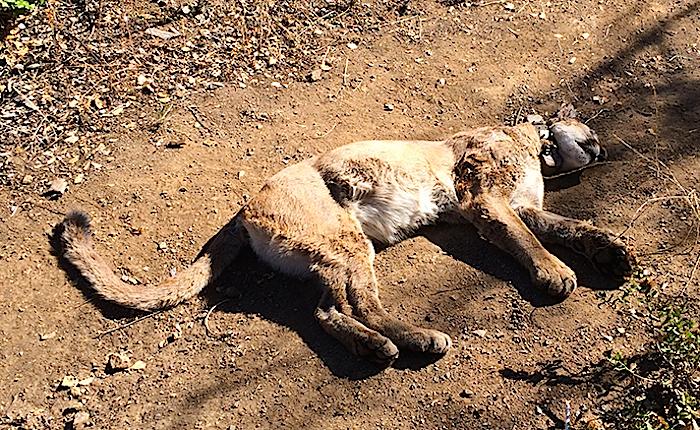Editor's note: The following article was written by Kate Kuykendall of the Santa Monica Mountains National Recreation Area staff.

This young mountain lion, P34, apparently died from consuming rat poison/NPS
Three young mountain lions have been found dead in the Santa Monica Mountains in recent weeks, illustrating how difficult it can be for the large carnivores to survive into adulthood in such an urbanized and fragmented landscape.
"If you're a mountain lion in the Santa Monica Mountains, this is just not an easy place to grow up," said Dr. Seth Riley, wildlife ecologist for the National Park Service. "From our roads to rat poisons to potentially increased interactions with other mountains lions, it is very difficult for young animals to make it to adulthood, establish their own home range and reproduce."
P-34, a juvenile female researchers began following when she was only three weeks old, was found by a runner on a trail in Point Mugu State Park on September 30.
Based on the preliminary results of a necropsy, which showed significant amounts of free blood in her chest cavity and around her heart, it appears that she died as a result of rodenticide poisoning. Wounds on her face and body indicated she had been in a fight just before her death, likely with another lion, but they were superficial and were not the direct cause of death.
National Park Service research has documented widespread exposure to rodenticides, also known as rat poisons, among wildlife in and around the Santa Monica Mountains. Two other mountain lions and many coyotes have died directly as a result of poisoning, and exposure to the poisons has been associated with a severe disease epidemic in bobcats.
P-34 made headlines last December when she was discovered lounging under a trailer in a mobile home park in Newbury Park. Earlier that day a resident snapped a stunning photo of P-34 walking in her backyard. Her sibling, P-32, was struck and killed by a vehicle on Interstate 5 this August after making a remarkable journey out of the Santa Monica Mountains.
In a separate incident last month, National Park Service biologist Jeff Sikich found the remains of P-43 and a previously unknown sibling in a remote part of the eastern Santa Monica Mountains. The two kittens were only three months old. P-43 was marked by biologists at three or four weeks of age and biologists at the time thought she was the only kitten in the litter.
The young kittens had been consumed by another animal. Forensic DNA results from UCLA will potentially provide more information on the species of animal involved in the attack and may even identify the specific individual, if it was one of the study's collared mountain lions.
P-43's mother, P-23, has had two litters of kittens and both litters have now been killed by other animals. Gridlocked, the urban wildlife blog for Santa Monica Mountains National Recreation Area, has more details about these cases of infanticide.
Infanticide is a form of intra-specific conflict, which is the number one cause of death since the National Park Service began studying mountain lions in and around the Santa Monica Mountains in 2002. The purpose of the study is to determine how they survive in an increasingly urbanized environment.
Scientists are currently tracking 10 animals in the region.



Comments
How ironic, you uses the word "strawman" in your strawman attack. Noone said anything about cave dwelling.
Or they don't think they are "issues" in the way you do.
Thanks, ec, for a perfect illustration of exactly what I mean.
I cannot help but think that EC's comment that "Yes, we are more important...." is reflective of the attitude that ultimately justified US manifest destiny and western expansion, which directly contributed to the demise of Native Americans and altered the ecological landscape of the continent.
National parks and wildlife preserves are places set aside to protect the natural environment, including species of very limited economic or ecological importance. As articulated by Dr. David Ehrenfeld some decades ago, the conservation of non-resources is a moral issue primarily. In our political/social system, other species have no voice, except for those who become aware of a moral obligation to protect and preserve natural habitat to ensure that continued human activities do not accelerate the rate of a loss of biodiversity and species extinction. Fortunately, there are many who do recognize a moral obligation to give nature a voice and essentially become a Lorax to speak out and fight for the rights of other species to coexist, even if protection of nature results in short-term economic impacts to humans.
Owen - manifest destiny and expansion have been with this world since man evolved. There is hardly a country that exists today that wasn't established through conquest - frequently at the expense of the natives. Even the Native Americans were guilty of that. (I would guess there are many Native Americans that are thinking like Mark Twain at the moment).
I am certainly not arguing that we don't have an obligation to protect our environment. My arguement is with the statement that we are no more important than than a mountain lion. We certainly are. Our obligation to protect must be kept in balance with our wants and needs as humans. While it is unfortunate this (these) mountain lions may have been killed by rat poison and we should try to minimize those occurances, I suspect the orginal poster would be first in line to call a lawyer should a rat run across the restaurant floor.